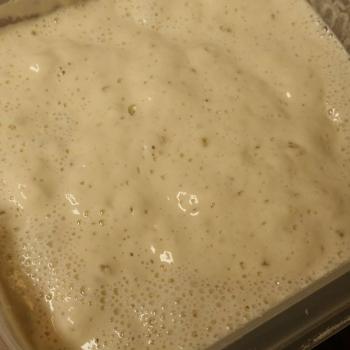
Mistura
19%
40%
41%
Líquido
Farinha
Outro
Spokan
desde 2014
A desire to find good, flavorful bread and not being able to find any locally.
Características
My sourdough starter was created in March 2014. It is named 'Spokan" after the name of the city and river where it was created. Specifically it was created near where Latah creek (aka Hangman creek) flows into the Spokane river, below the Spokane falls. It was created using flour and water only. The flour is sourced from the great wheat fields of eastern Washington known as The Palouse.
Sabor




Receita
Ingredientes iniciais
- 250g Water
- 500g Culture
- 500g Flour
- 20g Salt
Ingredientes para alimentar
- 250g Bread flour
- 250g Water
1
Since my starter is stored in the fridge, 24 hour before I will make bread dough, I pull the starter out, add equal parts flour and water, leave in the kitchen at room temperature.
250g Bread flour
250g Water
Método de trabalho
1
Bread Recipe 67% hydration
250 g water
500 g sourdough culture
500 g white bread flour
20 g non-iodized salt
250g Water
500g Culture
500g Flour
20g Salt
2
combine flour and water and allow to autolyse for 15 minutes.
3
add sourdough culture and salt.
4
knead by hand until all ingredients are thoroughly combined. Dough will be a shaggy mess. Do not add any additional flour. Keep kneading until dough becomes soft and rubbery, eventually you will get a feel for the stage in which the gluten is fully developed.
5
Check the dough for gluten development by using the 'window' method. Stretch a lump of dough until it is thin and translucent. If it tears or is not able to be pulled thin enough for light to show through the dough, keep kneading.
6
I used to meticulously keep track of every hour, now it just depends on ambient room temperature/ time of year, so I am more loose with timing. I feed my starter the day before (meaning I just used all of my starter and the only starter is the residue in the container, usually around 12 noon). Since I use 500 grams of starter, I add 250 g water and 250g high gluten bread flour.
7
The next morning, say 10 or 11, when the starter has at least doubled (depending on the weather, my house is kind of cold), I mix the dough. 500g flour plus 250 g water. I let it autolyse for 15 or 30 minutes, longer if I have something else to do, I'm not very picky. Then I add 500g starter and 20 g salt. I choose to knead the dough. Some like to do the stretch and fold a few times.
8
Either way develop the gluten. Kneading or time will accomplish the same thing. I like to knead by hand so that I can feel the dough, and feel when it changes to a smoother, stretchier state. I knead for about 15 minutes usually. Then let it bulk ferment for 4-6 hours (depends on how warm the day becomes) in a bowl covered with plastic wrap.
9
Once it has doubled in size, I divide the dough into two equal portions. I gently fold and roll the dough about 3 times. At this point you can let the dough rest for about 10-15 minutes, I usually skip the resting and form the dough using the tension pull technique. Then I place the round boules on doubled up baking sheets, on parchment paper.
10
I lightly flour them and cover with plastic for the final proof. ( I rub flour on the plastic wrap prior, so that it doesn't stick to itself so much). The final proof takes about 2 hours, When the loaves have risen (usually about by 50%). I pour about one half to three quarters of a cup of water on the bottom sheet pan, place the top sheet pan (with the parchment paper and loaves) on top, I cover
11
all of it with a large roasting pan (inverted, that is upside down, so that the steam is captured). I bake in a pre-heated gas oven for 20 minutes at 500'F, then remove the roasting pan, and bake for another 15 minutes, uncovered at 450'F. A dutch oven could be used, but I find them limiting ( only 1 loaf at a time), heavy and awkward to move around.
12
Really all you need is some way to keep the steam around the loaves for the first half of baking, so that the crust gets chewy. Then baked uncovered, so that the loaves get some nice color. I do not like hard crusts.
Result
Bread
2- 612 gram boules
tight crumb, good for sandwiches.







Comentários
This recipe is 67% hydration and makes 2 round loaves about 600 grams each. A long cold bulk ferment (in the fridge) enhances the flavor. It doesn't become more sour, but the flavor becomes more developed. I have done a six day cold ferment with excellent results. After the bulk ferment I divide the dough into equal halves and the final proof is between 2-4 hours depending on the room temperature/season.